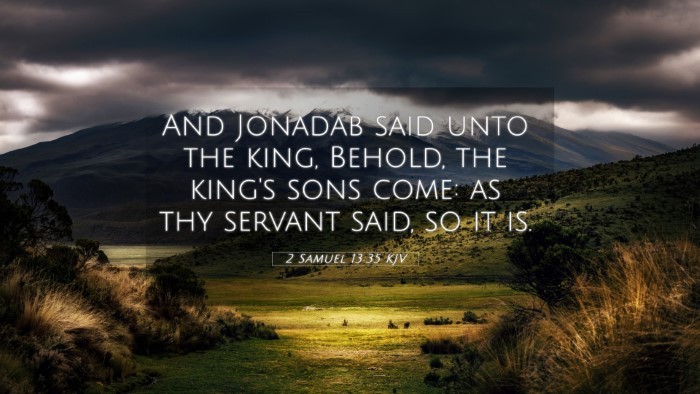Understanding 2 Samuel 13:35
Verse: 2 Samuel 13:35 - "And Jonadab said to the king, 'Look, the king's son is dead!' So the king stood up and tore his garments, and lay on the earth, and all his servants stood by with their clothes torn."
Summary of Insights
This verse occurs in the aftermath of Absalom's revenge for the rape of his sister Tamar by Amnon. Here, Jonadab, Amnon’s cousin, reveals the shocking news of Amnon's death to King David. This moment is pivotal as it encapsulates the themes of betrayal, grief, and the consequences of sin, which resonate throughout the narrative.
Commentary Insights
- Matthew Henry: Henry emphasizes the tragedy unfolding due to the family's internal strife, noting that Jonadab played a critical role in engineering the situation leading to death and despair. He suggests that the tearing of clothes signifies deep mourning and the profound impact of loss on David.
- Albert Barnes: Barnes highlights Jonadab's cunning nature, contrasting it with David’s emotional response. He notes that the revelation of Amnon's death is a significant moment, demonstrating the volatility that characterizes familial relationships in the royal house.
- Adam Clarke: Clarke draws connections between King David's response and previous moments of similar grief within the scripture, emphasizing that the act of tearing one’s garments has been a traditional mourning practice in ancient Israel.
Thematic Connections
The events depicted in this verse connect strongly to broader themes within the Bible, notably:
- Consequences of Sin: The verse illustrates how Amnon’s sin leads to dire consequences, reinforcing a recurring biblical theme that sin results in suffering.
- Family Betrayal: The tension within David's family highlights the tragic outcomes of strife rooted in sin and betrayal, which can be paralleled throughout scripture.
- Mourning and Grief: The actions of tearing garments symbolize mourning, a theme extensively covered in the Bible, signifying death and loss.
Bible Verse Cross-References
Here are several Bible verses that relate to the themes and events of 2 Samuel 13:35:
- 2 Samuel 13:28-29: Absalom's plan to kill Amnon is set in motion, showing the lead-up to this tragic event.
- Genesis 37:34-35: Jacob’s grief for Joseph serves as a parallel, illustrating how torn garments symbolize deep emotional pain.
- Matthew 26:65: The act of tearing garments is also reflected in the High Priest’s reaction during Jesus’ trial, showing continuity in mourning and loss in the biblical narrative.
- Proverbs 13:15: Discussing the outcome of wickedness echoes the moral lessons surrounding the consequences of immorality, paralleling Amnon's fate.
- Galatians 6:7: This verse speaks to reaping what one sows, encapsulating the overarching theme of consequences found in 2 Samuel's narrative.
- James 1:15: The progression of sin leading to death is mirrored in the life of Amnon and the havoc it wreaks within David’s family.
- Luke 22:47-48: Betrayal leading to death can be seen in Judas's kiss, reflecting familial and friend betrayals across scripture.
- Philippians 3:19: The fate of those who indulge in earthly desires versus the faithful is explored, echoing the internal conflict within David's house.
Inter-Biblical Dialogue
The themes presented in 2 Samuel 13:35 invoke rich inter-biblical dialogue. The elements of betrayal, sin, and grief connect not only this narrative to others in the Old Testament but also find echoes in the New Testament, emphasizing the timeless nature of these experiences. For example, the betrayal of familial trust resonates through the story of Joseph and his brothers, as well as through the trials of Jesus and his disciples.
Conclusion
In synthesizing insights from respected public domain commentaries, it becomes clear that 2 Samuel 13:35 serves as a stark reminder of the ramifications of sin within familial structures, the deep emotional responses tied to loss, and the enduring relevance of these themes across the biblical text. Engaging with cross-references, we can better understand the interconnected narratives of grief, betrayal, and the search for redemption in scripture.


